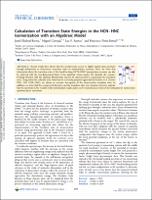Please use this identifier to cite or link to this item:
https://hdl.handle.net/20.500.12202/6444Full metadata record
| DC Field | Value | Language |
|---|---|---|
| dc.contributor.author | Khalouf-Rivera, Jamil | |
| dc.contributor.author | Carvajal, Miguel | |
| dc.contributor.author | Pérez-Bernal, Francisco | |
| dc.contributor.author | Santos, Lea F. | |
| dc.date.accessioned | 2020-11-19T16:31:49Z | |
| dc.date.available | 2020-11-19T16:31:49Z | |
| dc.date.issued | 2019-10-09 | |
| dc.identifier.citation | Santos, Lea F., Jamil Khalouf-Rivera, Miguel Carvajal, Francisco Pérez-Bernal. (2019). Calculation of transition state energies in the hcn–hnc isomerization with an algebraic model. The Journal of Physical Chemistry A 123(44): 9544-9551. | en_US |
| dc.identifier.issn | Print: 1089-5639 Electronic: 1520-5215 | |
| dc.identifier.uri | https://doi.org/10.1021/acs.jpca.9b07338 | en_US |
| dc.identifier.uri | https://hdl.handle.net/20.500.12202/6444 | |
| dc.description | Research article/ peer-reviewed. Open Access. | en_US |
| dc.description.abstract | Recent works have shown that the spectroscopic access to highly excited states provides enough information to characterize transition states in isomerization reactions. Here, we show that information about the transition state of the bond-breaking HCN–HNC isomerization reaction can also be achieved with the two-dimensional limit of the algebraic vibron model. We describe the system’s bending vibration with the algebraic Hamiltonian and use its classical limit to characterize the transition state. Using either the coherent state formalism or a recently proposed approach by Baraban [ Science 2015, 350, 1338–1342], we obtain an accurate description of the isomerization transition state. In addition, we show that the energy-level dynamics and the transition state wave function structure indicate that the spectrum in the vicinity of the isomerization saddle point can be understood in terms of the formalism for excited-state quantum phase transitions. | en_US |
| dc.description.sponsorship | ■ ACKNOWLEDGMENTS The authors thank José Miguel Arias, José Enrique Garcıá - Ramos, Franco Iachello, Georg Mellau, and Pedro Pérez Fernández for useful discussions and comments. J.K.-R. is grateful for the support from the Youth Employment Initiative and the Youth Guarantee program supported by the European Social Fund. L.F.S. is supported by the NFS Grant No. DMR- 1603418. This study has been partially financed by the Consejerıá de Conocimiento, Investigacioń y Universidad, Junta de Andalucıá and European Regional Development Fund (ERDF), ref SOMM17/6105/UGR and by the Centro de Estudios Avanzados de Fıś ica, Matemat́ icas y Computacioń (CEAFMC) of the Universidad de Huelva. Computer resources supporting this work were provided by the CEAFMC and Universidad de Huelva High Performance Computer (HPC@UHU) located in the Campus Universitario El Carmen and funded by FEDER/MINECO project UNHU- 15CE-2848. | en_US |
| dc.language.iso | en_US | en_US |
| dc.publisher | American Chemical Society | en_US |
| dc.relation.ispartofseries | The Journal of Physical Chemistry A;123(44) | |
| dc.rights | Attribution-NonCommercial-NoDerivs 3.0 United States | * |
| dc.rights.uri | http://creativecommons.org/licenses/by-nc-nd/3.0/us/ | * |
| dc.subject | Transition states | en_US |
| dc.subject | Hamiltonians | en_US |
| dc.subject | Isomerization | en_US |
| dc.subject | Energy | en_US |
| dc.subject | Spectroscopy | en_US |
| dc.title | Calculation of transition state energies in the hcn–hnc isomerization with an algebraic model. | en_US |
| dc.type | Article | en_US |
| dc.contributor.orcid | 0000-0001-9400-2709 | |
| local.yu.facultypage | https://www.yu.edu/faculty/pages/santos-lea | |
| Appears in Collections: | Stern College for Women -- Faculty Publications | |
Files in This Item:
| File | Description | Size | Format | |
|---|---|---|---|---|
| Santos Calculation 2019 acs.jpca.9b07338.pdf | 368.33 kB | Adobe PDF |  View/Open |
This item is licensed under a Creative Commons License

